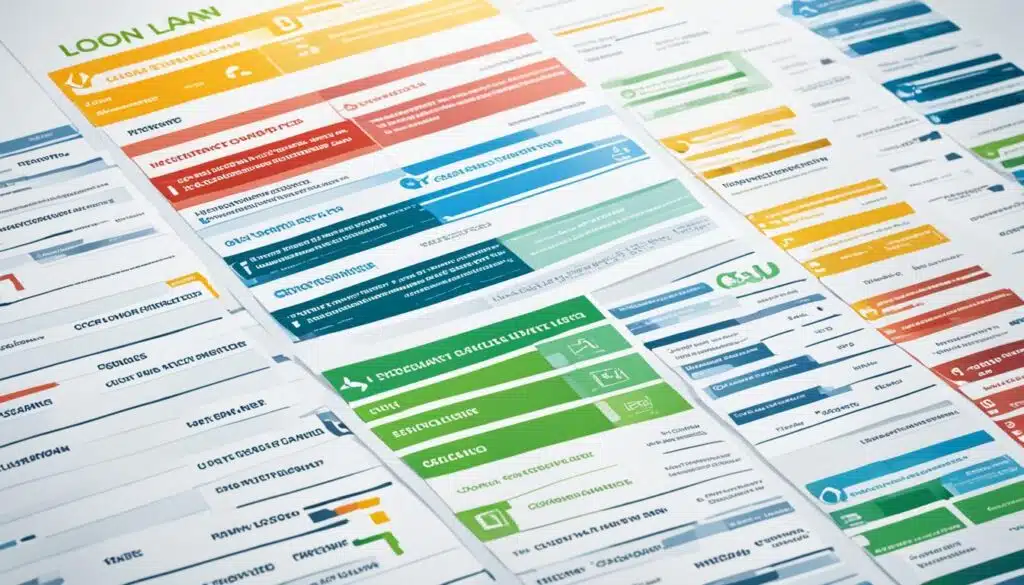The loan approval process is a crucial step in securing a mortgage or home loan. It involves several stages, including applying for a loan, submitting necessary documents, and undergoing underwriting. Lenders assess factors such as credit score, income, and debt-to-income ratio to determine the borrower’s eligibility. The process also involves obtaining a loan estimate, reviewing closing costs, and finalizing the loan terms. Throughout this guide, we will delve into each step of the loan approval process, providing valuable insights and tips for navigating it seamlessly.
Key Takeaways:
- The loan approval process is essential for securing a mortgage or home loan.
- Lenders evaluate factors such as credit score, income, and debt-to-income ratio to determine eligibility.
- Obtaining a loan estimate and reviewing closing costs are crucial steps in the process.
- Understanding the loan approval process can help borrowers navigate it effectively.
- Working with a trusted lender is important for a successful loan approval.
Understanding Loan Application and Pre-approval
The first step in the loan approval process is filling out a loan application. This involves providing personal and financial information to the lender. The lender will then evaluate the application and determine if the borrower meets their initial criteria for pre-approval.
Pre-approval is a preliminary evaluation that gives the borrower an idea of how much they may be able to borrow based on their credit score, income, and other financial factors. It’s important to note that pre-approval is not a guarantee of final loan approval, but it can be a helpful tool in the home buying process.
When filling out the loan application, it’s crucial to provide accurate and complete information about your financial situation. This includes details such as your income, employment history, assets, and debts. The lender will use this information to assess your creditworthiness and determine if you qualify for a loan.
“Pre-approval is not a guarantee of final loan approval, but it can be a helpful tool in the home buying process.”
One of the key factors that lenders consider during the loan application and pre-approval process is your credit score. A higher credit score indicates a lower risk to the lender and may improve your chances of getting approved for a loan. It’s important to check your credit score before applying for a loan and take steps to improve it if necessary.
In addition to credit score, lenders will also evaluate your income and other financial factors such as your debt-to-income ratio. They want to ensure that you have a stable income and are financially capable of repaying the loan.
Pre-approval gives you an estimate of how much you can borrow, which can help you narrow down your home search and set a realistic budget. It also shows sellers that you are a serious buyer and can give you an advantage in a competitive housing market.
| Loan Application and Pre-approval Checklist |
|---|
| 1. Gather all necessary financial documents, including pay stubs, tax returns, and bank statements. |
| 2. Check your credit score and address any issues or errors. |
| 3. Research lenders and compare loan options to find the best fit for your needs. |
| 4. Fill out the loan application accurately and completely. |
| 5. Submit the application along with all required documents to the lender. |
| 6. Await pre-approval decision and review the offer carefully. |
| 7. Use the pre-approval to guide your home search and make an offer when you find the right property. |
By understanding the loan application and pre-approval process, you can be better prepared when applying for a loan and increase your chances of securing the financing you need for your dream home.
Gathering and Submitting Documents
Once the loan application is submitted, it is essential for the borrower to gather and submit the necessary documents to support their financial information. These documents play a crucial role in the underwriting process, during which the lender reviews the loan application and accompanying materials to make a final decision on loan approval.
Submitting the required documents is a vital step in the loan approval process as it provides the lender with the information needed to verify the borrower’s financial situation and assess their creditworthiness. Some of the necessary documents may include:
- Proof of income: This can include recent pay stubs, W-2 forms, or tax returns to demonstrate the borrower’s ability to repay the loan.
- Bank statements: Providing bank statements helps to showcase the borrower’s financial stability and shows the lender their cash reserves.
- Tax returns: This allows the lender to review the borrower’s income history and ensure it aligns with the information provided in the loan application.
- Documentation of assets or debts: This may include statements for investments, retirement accounts, or any outstanding loans or debts the borrower has.
By submitting these necessary documents, the borrower assists the lender in assessing their creditworthiness and making informed decisions regarding the loan application. It is crucial to provide accurate and complete documentation to expedite the underwriting process and increase the likelihood of loan approval.
Understanding Credit Score and History
Credit score plays a significant role in the loan approval process. Lenders use the borrower’s credit score, which is derived from their credit report, to assess their creditworthiness. A higher credit score indicates a lower risk to the lender and may result in more favorable loan terms.
It’s essential for borrowers to review their credit reports regularly, as they provide a comprehensive record of their credit history. A credit report includes information such as current and past credit accounts, payment history, and any outstanding debts. By examining their credit report, borrowers can identify any errors or discrepancies that could impact their credit score.
Addressing these errors and discrepancies is crucial, as they can negatively affect the borrower’s creditworthiness. By contacting the credit reporting agency and providing supporting documentation, borrowers can request corrections to their credit report. This process may take time, so it’s important to address any issues well in advance of applying for a loan.
Improving Your Credit Score
If a borrower’s credit score is below the desired range for loan approval, they can take steps to improve it. One crucial factor is making timely payments on all outstanding debts, such as credit card bills, student loans, and car payments. Consistently meeting payment deadlines demonstrates financial responsibility and can have a positive impact on the credit score over time.
Reducing credit card balances can also improve creditworthiness. Lenders consider the credit utilization ratio, which is the percentage of available credit that a borrower is using. Keeping this ratio below 30% can help boost credit scores.
Another strategy for improving creditworthiness is avoiding new credit applications. Each time a borrower applies for new credit, it can temporarily lower their credit score. It’s important to carefully consider the necessity of new credit before applying.
“Maintaining a good credit score is crucial for loan approval. Lenders rely on credit scores to assess the borrower’s creditworthiness and determine the risk involved in granting a loan.”
–John Anderson, Loan Officer at XYZ Bank
The Importance of Creditworthiness
Creditworthiness is a measure of an individual’s ability to repay their debts. Lenders consider creditworthiness when deciding whether to approve a loan application. A higher creditworthiness increases the chances of loan approval and may result in more favorable loan terms, such as lower interest rates or lower down payment requirements. On the other hand, a lower creditworthiness may lead to loan denials or less favorable loan terms.
When assessing creditworthiness, lenders take into account various factors, including credit score, income, employment history, and debt-to-income ratio. A strong credit score coupled with a stable income and employment history can significantly improve creditworthiness, making a borrower more attractive to lenders.
By understanding the importance of credit score and creditworthiness, borrowers can take proactive steps to manage and improve their credit. Regularly monitoring credit reports, addressing inaccuracies or discrepancies, and practicing good credit habits can pave the way for loan approval and better loan terms.
Underwriting and Loan Approval
Underwriting is a critical step in the loan approval process. The lender carefully reviews the borrower’s loan application, supporting documents, and credit history to assess their ability to repay the loan. This comprehensive evaluation involves considering factors such as debt-to-income ratio, employment history, and assets. The underwriter may request additional documents or information during this stage to ensure a thorough assessment. Once the underwriting process is complete, the lender will make a final decision on loan approval and communicate the loan terms to the borrower. However, it’s important to note that there may be conditions that need to be met before final approval is granted.
“Underwriting is like peeling an onion. Your application file is examined layer by layer to determine if you meet the lender’s requirements.” – Mortgage Expert
During the underwriting process, the lender carefully analyzes the loan file, assessing the borrower’s financial stability and creditworthiness. The lender wants to ensure that lending to the borrower is a low-risk proposition. The underwriter evaluates various aspects such as the borrower’s income, employment stability, credit history, and assets. By conducting this in-depth review, the lender can make an informed decision about loan approval and set appropriate loan terms.
“Underwriting is the backbone of the loan approval process. It establishes the foundation for a successful borrower-lender relationship by mitigating risks and ensuring sound lending decisions.”
After reviewing the loan file, the underwriter may provide conditional loan approval. These conditions may require the borrower to provide additional documentation or meet specific requirements within a given timeframe. Common conditions can include providing updated pay stubs, explanations of certain transactions, or resolving outstanding credit issues. It’s crucial for the borrower to promptly address these conditions to expedite the final approval process.
The underwriting process requires a high level of expertise and attention to detail. The underwriter not only ensures the borrower’s ability to repay the loan but also safeguards the lender’s interests. Effective communication between the underwriter, loan officer, and borrower is essential for a smooth underwriting process. It’s important for the borrower to be open and responsive to any requests or inquiries from the underwriter to facilitate timely approval.
Key Factors Considered in Underwriting
| Factors | Importance |
|---|---|
| Credit History | High |
| Debt-to-Income Ratio | High |
| Employment History | High |
| Asset Verification | Medium |
| Documentation Completeness | Medium |
| Property Appraisal | Medium |
Underwriting plays a pivotal role in the loan approval process, enabling lenders to make informed decisions based on thorough evaluations. By carefully examining the borrower’s loan file, credit history, and financials, the underwriter ensures that the loan is suitable for both the borrower and the lender. It’s a crucial step that sets the stage for successful loan terms that align with the borrower’s financial needs and goals.
Understanding Loan Estimates and Closing Costs
When applying for a mortgage, it’s important to have a clear understanding of the loan estimate and closing costs. These financial factors play a significant role in the overall affordability of the loan and should be carefully considered before making a final decision.
Loan estimate: The loan estimate is a document provided by the lender that outlines the estimated costs associated with obtaining the loan. It includes important details such as the interest rate, loan amount, and any applicable fees. The loan estimate also includes an estimate of the borrower’s monthly mortgage payment, which helps in determining whether the loan is manageable within their budget.
Closing costs: Closing costs are the fees and expenses that are incurred during the closing of the loan. These costs typically include appraisal fees, title insurance, attorney fees, and property taxes. It’s important for borrowers to carefully review the closing costs outlined in the loan estimate to ensure they are prepared for these financial obligations.
Lender fees: Lender fees are specific fees charged by the lender for processing and closing the loan. These fees can vary from lender to lender and may include origination fees, underwriting fees, or document preparation fees. It’s essential for borrowers to understand the lender fees outlined in the loan estimate and factor them into their overall budget.
Interest rate: The interest rate is the percentage charged by the lender for borrowing the funds. It directly impacts the total cost of the loan over its lifetime. The loan estimate will provide the borrower with the estimated interest rate based on their financial profile and current market conditions. Understanding the interest rate helps borrowers evaluate whether the loan is financially advantageous for them.
Mortgage insurance: Mortgage insurance is often required for borrowers who make a down payment of less than 20%. It provides protection to the lender in case the borrower defaults on the loan. The loan estimate will indicate whether mortgage insurance is required and detail the associated costs. It’s crucial for borrowers to consider these costs when assessing the affordability of the loan.
Property taxes: Property taxes are an additional expense to consider when owning a property. The loan estimate may include an estimate of the property taxes based on the property’s assessed value and the local tax rate. It’s important for borrowers to account for property taxes when determining the total cost of homeownership.
It’s recommended that borrowers carefully review the loan estimate and closing costs with their lender. This will help ensure transparency and provide an opportunity to ask any questions or seek clarification on the financial implications of the loan. By understanding these key factors, borrowers can make informed decisions and choose a mortgage that aligns with their financial goals.
Types of Loans and Loan Programs
When it comes to securing a loan, borrowers have a variety of options available to them. These loan programs cater to different needs and requirements, providing a range of choices to suit individual circumstances. Understanding the types of loans available can help borrowers make informed decisions and select the best program for their specific situation.
Conventional Loans
Conventional loans are one of the most common types of loans offered by private lenders. They typically come with competitive interest rates and are suitable for borrowers with strong credit scores and stable income. Conventional loans require a down payment, usually ranging from 3% to 20% of the purchase price, depending on the lender’s requirements and the borrower’s creditworthiness.
FHA Loans
FHA loans are insured by the Federal Housing Administration and are designed to help borrowers with lower down payments and more flexible credit requirements. These loans are popular among first-time homebuyers who may not have a large down payment saved up or have less-than-perfect credit. FHA loans often require a down payment as low as 3.5% of the purchase price and may have more lenient credit score requirements.
VA Loans
VA loans are specifically available to eligible veterans and are guaranteed by the Department of Veterans Affairs. These loans offer a range of benefits, including no down payment requirement and more flexible credit guidelines. VA loans are a great option for military service members, veterans, and their families looking to purchase a home.
Jumbo Loans
Jumbo loans are used for loan amounts that exceed the conforming loan limits set by Fannie Mae and Freddie Mac. These loans are often required for higher-priced properties or homes in expensive real estate markets. Jumbo loans typically come with stricter requirements, such as a larger down payment and higher credit score.
USDA Loans
USDA loans are designed to assist borrowers in designated rural areas who meet income requirements. These loans are backed by the U.S. Department of Agriculture and offer benefits such as no down payment and flexible credit guidelines. USDA loans are an excellent option for borrowers looking to purchase a home in eligible rural areas.
Each type of loan and loan program has its own specific requirements and eligibility criteria. Understanding the nuances of each option can help borrowers make informed decisions and choose the loan program that best aligns with their needs and financial situation.
Finalizing the Loan and Closing
After obtaining the final approval for your loan, the next step is to finalize the loan and close the deal. This involves several important tasks and collaborations with key professionals in the real estate industry. Here’s what you need to know about finalizing the loan and closing the deal:
1. Review and sign the loan documents:
Once your loan is approved, you will receive a set of loan documents from your lender. It is essential to carefully review these documents to ensure loan terms and conditions align with your expectations and requirements. Take your time to read through the documents, ask any questions you may have, and clarify any doubts before signing them.
2. Pay closing costs:
During the closing process, you will be required to cover various costs known as closing costs. These costs include appraisal fees, title insurance, attorney fees, and other miscellaneous charges. It’s important to have a clear understanding of the closing costs associated with your loan and budget accordingly.
3. Work with a real estate agent and title company:
Throughout the closing process, you may work closely with a real estate agent and a title company. The real estate agent will assist you in coordinating the necessary paperwork and ensure all parties involved are on the same page. The title company will handle the title search, title insurance, and the transfer of ownership process.
4. Ensure all documents are in order before closing day:
Prior to the closing day, it is crucial to carefully review all the relevant documents and ensure everything is in order. This includes verifying that the loan terms, interest rate, and loan amount match what was initially agreed upon. Any discrepancies or issues should be addressed and resolved before the closing day.
5. Transfer ownership and become a homeowner:
On the closing day, the final step is to transfer ownership of the property from the seller to the buyer. This process typically involves signing the necessary documents, paying the remaining closing costs, and receiving the keys to your new home. Congratulations, you are now officially a homeowner!
| Closing Costs | Description |
|---|---|
| Appraisal Fees | The cost of a professional appraisal to determine the value of the property. |
| Title Insurance | A policy that protects the buyer and lender from any unforeseen issues with the property’s title. |
| Attorney Fees | Fees associated with legal representation during the closing process. |
| Miscellaneous Charges | Additional fees like recording fees, notary fees, and courier fees. |
Remember, finalizing the loan and closing the deal marks the completion of an important milestone on your journey to homeownership. By working closely with professionals, carefully reviewing documents, and ensuring all necessary steps are completed, you can confidently secure your dream home.
Managing Your Mortgage and Long-Term Planning
Once the loan is finalized and the borrower becomes a homeowner, it’s important to effectively manage the mortgage and plan for the long term. By staying proactive and informed, homeowners can maintain financial stability and work towards their financial goals.
1. Make Regular Mortgage Payments
One of the key aspects of managing your mortgage is making regular mortgage payments. This ensures that you stay on track with your loan and avoid any potential penalties. It’s essential to prioritize your mortgage payment within your budget and make timely payments to maintain a good payment history.
2. Stay Informed About Changes in Interest Rates
Interest rates can have a significant impact on your mortgage payment and overall financial situation. Stay informed about changes in interest rates and consider refinancing if there is an opportunity to secure a lower interest rate. Refinancing can help reduce your monthly mortgage payment and potentially save you money in the long run.
3. Periodically Reassess Financial Goals
Financial goals can change over time, so it’s important to periodically reassess them. Evaluate your long-term goals and consider how they align with your current mortgage situation. If your goals have changed, you may need to adjust your financial plan accordingly to ensure your mortgage fits into your overall financial goals.
4. Create a Budget and Plan for Long-Term Stability
Creating a budget that includes all homeownership costs beyond the mortgage payment is essential for long-term stability. Take into account property taxes, insurance, and maintenance expenses to ensure you can comfortably afford your home. This comprehensive budget will help you manage your finances effectively and prepare for any unexpected expenses that may arise.
5. Regularly Review and Adjust Your Mortgage Management Approach
Regularly reviewing and adjusting your mortgage management approach can provide long-term stability and peace of mind. Take time to assess your financial situation, evaluate any changes in the housing market, and consider refinancing options if it aligns with your goals. Stay proactive and make any necessary adjustments to ensure your mortgage continues to support your financial well-being.
| Benefits of Mortgage Management | How to Achieve Long-Term Stability |
|---|---|
| 1. Lower interest rate | 1. Create a comprehensive budget |
| 2. Reduced monthly mortgage payment | 2. Stay informed about changes in interest rates |
| 3. Improved financial flexibility | 3. Regularly reassess financial goals |
| 4. Potential savings through refinancing | 4. Make regular mortgage payments |
| 5. Long-term financial stability | 5. Review and adjust mortgage management approach |
Getting a mortgage involves several steps of the mortgage loan process, starting with mortgage pre-approval to determine how much home you can afford. At this stage, you’ll need to qualify for a mortgage based on your credit score and income. Once you choose a mortgage lender, you’ll begin the loan processing stage, where you’ll gather the necessary documents needed to get a loan. The loan processor will then compile your loan file and submit it for underwriting. Depending on the type of loan you’re getting, such as VA loans or conventional mortgage rates, the process can be easier or more complex. During underwriting, the lender will finalize the loan terms and conditions, and you’ll receive final approval. It’s a good idea to shop around with at least three mortgage lenders to find the best terms and rates. Once everything is in order, you’ll close on the loan with a closing attorney or title company, and keys to your new home will be yours.
Also Read: How To Become A Loan Officer?
Conclusion
The loan approval process is a critical and intricate journey towards securing a home loan. Every stage, requirement, and consideration holds immense significance in achieving favorable loan terms. From the initial loan application to the final closing, each step plays a pivotal role in the borrower’s path to homeownership. With comprehensive understanding of the loan approval process and the guidance of a trusted lender, prospective buyers can navigate this complex terrain and turn their dreams of owning a home into a reality.
By being well-informed about the loan approval process, borrowers can confidently move forward and make informed decisions. It is crucial to grasp the intricacies involved in working with lenders, managing underwriting, and handling closing costs. Additionally, staying mindful of the influence of credit score on loan approval helps borrowers maintain good financial standings and secure more favorable terms. Successfully maneuvering through the loan approval process is key to obtaining a home loan that aligns with one’s needs and goals.
Ultimately, securing a home loan requires knowledge, diligence, and collaboration. By understanding the loan approval process and working hand in hand with lenders, prospective buyers can overcome hurdles and achieve their aspirations. Whether it’s navigating underwriting or managing closing costs, borrowers who are well-prepared and informed will be in a better position to secure the home loan they desire. Remember, every step taken brings individuals closer to the exciting milestone of homeownership.
FAQs
Q: What is the mortgage loan process?
A: The mortgage loan process involves securing a loan to purchase a home by submitting an application, providing necessary documentation, undergoing underwriting, and ultimately closing on the loan.
Q: How do I choose a mortgage lender?
A: To choose a mortgage lender, you should consider factors such as interest rates, fees, customer service, reputation, and the types of loans they offer.
Q: What is mortgage pre-approval?
A: Mortgage pre-approval is when a lender examines your financial situation and determines the amount you are qualified to borrow, giving you a clear understanding of your home buying budget.
Q: What is loan processing in the home loan approval process?
A: Loan processing involves gathering all necessary documentation, verifying information, and preparing the loan application for underwriting to assess your eligibility for a mortgage.
Q: What is conditional approval in the mortgage process?
A: Conditional approval means that the lender is willing to move forward with the loan, pending certain conditions such as additional documentation or property appraisal.
Q: What happens on closing day?
A: On closing day, you will sign all the final paperwork, pay any remaining closing costs, and officially take ownership of the property, completing the home buying process.
Q: What are the different types of mortgage loans available?
A: There are various types of mortgage loans, such as fixed-rate mortgages, adjustable-rate mortgages, FHA loans, VA loans, USDA loans, and jumbo loans, each offering different terms and requirements.
Q: How do I qualify for a mortgage?
A: To qualify for a mortgage, you need to have a good credit score, stable income, low debt-to-income ratio, and sufficient savings for a down payment and closing costs.
Source Links
- https://www.x2mortgage.com/blog/decoding-conventional-mortgage-loans-a-comprehensive-guide-for-first-time-homebuyers
- https://www.linkedin.com/pulse/decoding-mortgage-lingo-homebuyers-comprehensive-guide-chris-black
- https://www.ourpsb.com/2024/02/06/decoding-the-abcs-of-psb-lending-a-comprehensive-guide/












